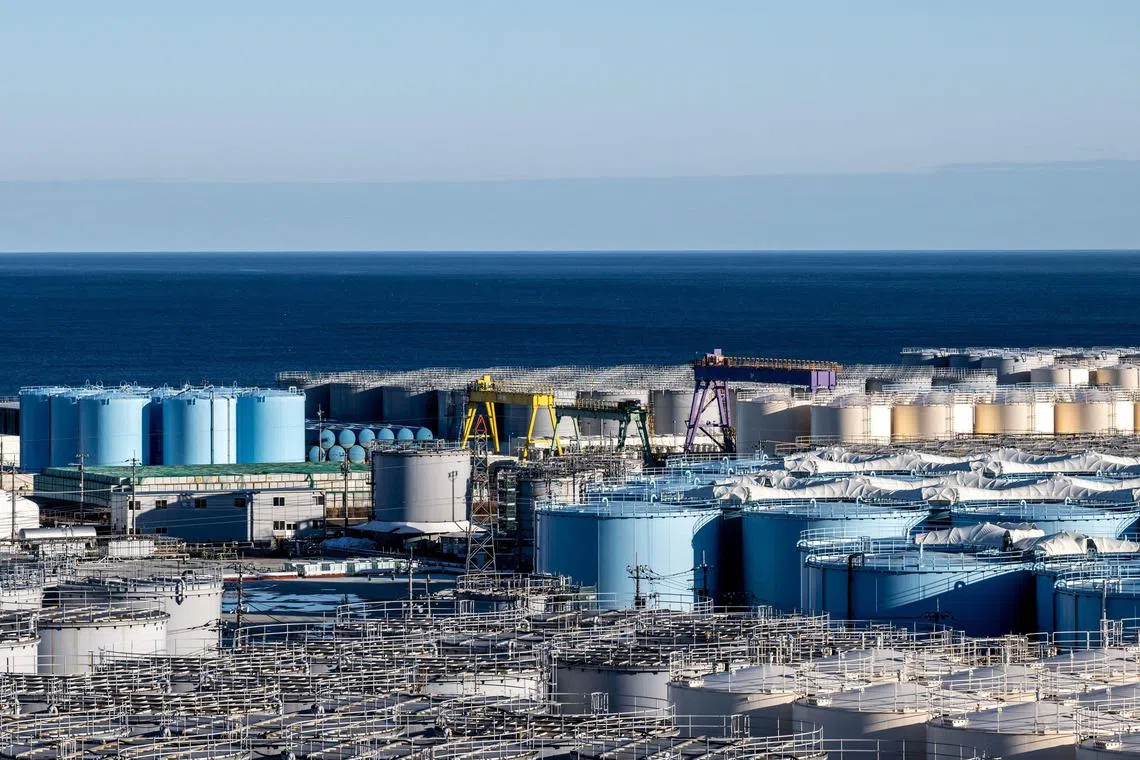Japan fighting disinformation, psychological fears ahead of Fukushima water release on Aug 24
Sign up now: Get ST's newsletters delivered to your inbox

Storage water tanks at the Tokyo Electric Power Company's (Tepco) Fukushima Daiichi nuclear power plant.
PHOTO: AFP
Follow topic:
TOKYO – Japan says it is safe. So does the International Atomic Energy Agency (IAEA),
Yet despite overwhelmingly sound scientific evidence,
Prime Minister Fumio Kishida said on Tuesday that his government will be fully accountable.
Japan is fighting a psychological and disinformation battle amid fearmongering and the ostensible weaponisation of the water release for geopolitical gains.
In China, where rigid radiation checks are already holding up imports, foreign ministry spokesman Wang Wenbin said: “The ocean is the common property of all humankind, not a place for Japan to arbitrarily dump nuclear-contaminated water.”
Hong Kong imposed controls on seafood shipments from Japan on Tuesday. Russia has also vilified the plan, while several Pacific Island nations are uneasy.
The discharge threatens to complicate Japan’s flowering ties with South Korea,

Activists attend a protest in Seoul against Japan’s plan to release treated wastewater from the Fukushima nuclear power plant into the ocean.
PHOTO: REUTERS
At home, Mr Kishida’s government is accused of breaking a sacred promise to Fukushima fishermen, who are vehemently opposed to the release amid perceptions of a fait accompli.
Third-generation fisherman Haruo Ono, 71, told TBS News: “It’s ridiculous that the government can break its promise. Who is going to buy our fish?”
In 2015, the ruling government had said water discharge will not begin without the consent of all stakeholders. Media headlines point to how Mr Kishida met the national fisheries’ association chief Masanobu Sakamoto, of Chiba prefecture, but gave Fukushima fishermen short shrift.
To cope with damage arising from disinformation and so-called “harmful rumours”, Tokyo is setting aside 80 billion yen (S$744.5 million) to, among other things, buy back unsold excess fish that will be kept frozen until they can be sold.
The discharge, to begin with what operator Tokyo Electric Power Company (Tepco) describes as a “small scale” release for safety verification, will be irreversible and last until the decommissioning is completed in 2051 at the earliest.
But emergency valves are installed that can stop the outflow immediately in case of anomalies.
Radioactive water is a by-product that continues to accumulate at Fukushima Daiichi, which in 2011 witnessed one of the world’s worst nuclear disasters.
The plant is quickly running out of space, with over 1,000 water tanks – now 97 per cent full and containing over 1.34 million tonnes of water – impeding the decommissioning process.
Tepco expects to release 31,200 tonnes of water by March 2024. Through an Advanced Liquid Processing System (ALPS), the water will first be purified to remove all radioactive nuclides except tritium, which is radioactive but harmless in small doses.
The naturally-occurring hydrogen isotope is present in rainfall and is a routine by-product of all nuclear plants worldwide for over 60 years.
To ease fears, Tepco is diluting the water beyond necessary. The water to be pumped out will contain tritium levels at one-seventh that of World Health Organisation drinking water standards, and 1/40th of Japan’s more stringent regulations.
This also makes Fukushima tritium levels far lower than the discharge from nuclear plants worldwide, including China’s, with the IAEA vouching “negligible radiological impact to people and the environment”.
But many people still do not know that tritium exists all around them, and are terrified of the idea of water pumped out from a crippled nuclear plant.
“How laypersons assess risk is shaped by their emotionality and interpretation of events,” Professor Heng Yee Kuang of the University of Tokyo’s Graduate School of Public Policy told The Straits Times.
“Compared to technical experts, they tend to outweigh the risks of unfamiliar, involuntary and infrequent events.”

Prof Heng said that in Fukushima’s case, there was both a “dread risk” over fears of catastrophic impact and a visceral “yuck factor” that was seen in the negative associations for Singapore’s own NEWater – recycled from sewage wastewater – when it was first rolled out.
Meanwhile, China and Russia are arguing for vapour release into the air, though Japan and the IAEA say this is far less realistic because it would be impossible to monitor the impact.
Tokyo, in a diplomatic response on Aug 18, said China has not only ignored Japanese offers for bilateral meetings on the water discharge, but also “continued to spread scientifically unfounded claims... that reflect an unwillingness to accept well-documented scientific fact, or authoritative analysis from independent international sources”.
Japan’s solution is transparency. The Tepco website is chock-full of data, while the IAEA in July set up an office in Fukushima.
After the discharge, Japan will monitor radioactivity in nearby waters and test seafood daily – data that will be provided online.
Japan Institute of International Affairs think-tank director Koichiro Matsumoto told ST that “perfect, total, and absolute accountability” was necessary in the face of “unscientific scaremongering narratives”.
In Australia, Curtin University physicist Nigel Marks agreed that the ocean discharge was the “only practical option”.
He said: “For scale, the Pacific Ocean contains 8,400g of pure tritium, while Japan will release 0.06g of tritium every year. The minuscule amount won’t make the tiniest jot of difference.
“A lifetime’s worth of seafood caught a few kilometres from the ocean outlet will have the tritium radiation equivalent of one bite of a banana.”


